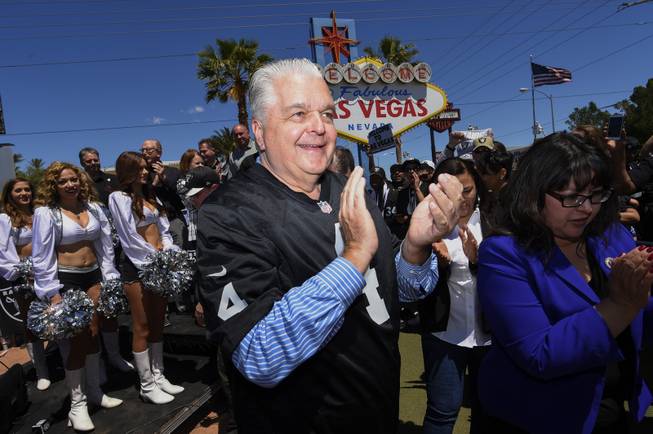
Sam Morris/Las Vegas News Bureau
Clark County Commission Chairman Steve Sisolak leaves after announcing former Wake Forest linebacker Marquel Lee as the Raiders fifth round draft pick during an event in front of the “Welcome to Fabulous Las Vegas” sign Saturday, April 28, 2017.
Friday, Dec. 15, 2017 | 2 a.m.
Related content
- Deadlines again creep up on Raiders, stadium authority to finish project documents
- Raiders break ground on future home while continuing long goodbye to old one
- Why Raiders, L.V. Stadium Authority are struggling with community benefits plan
- Las Vegas aims to host Super Bowl, NFL Draft, FIFA World Cup
- More Raiders to Las Vegas coverage
This stadium authority meeting did not start Thursday. It pretty much just continued from November’s icy gathering right through a much warmer 90 minutes at UNLV’s Foundations Building.
The tensions of last month’s meeting prompted a frank session initiated by Clark County Commission Chairman Steve Sisolak, the de facto intermediary between Southern Nevada and the East Bay. More to the point, Raiders President Marc Badain called it “a swift kick in the ass.”
Sisolak had watched as Raiders Executive Vice President Dan Ventrelle defended the Raiders' community benefits proposal at the November meeting, at times in harsh tones when questioned by board Chairman Steve Hill and member Ken Evans.
“That’s why I asked to get them together,” Sisolak said. “Not just tensions — it just wasn’t making progress.”
With the community benefits plan discussions stuck and the UNLV joint-use agreement talks entering a sixth month of the sides publicly referring to progress unseen, intervention appeared necessary. Raiders representatives joined the UNLV negotiating team and stadium authority staff for what became a three-hour meeting that required finesse and compromise.
When that discussion concluded, the UNLV group left the room, leaving the Raiders and stadium authority to hash out their remaining issues on the benefits plan. That took another hour, Sisolak said.
“It was a great meeting when we were done,” Sisolak said. “They came in and there was a bit of tension and there was a bit of of animosity, maybe. But it was all put aside and everyone is on the absolute same page and the same line right now.”
Those talks led to Thursday, a day that proved eventful because both challenging agreements are largely completed, yet uneventful because of how smoothly the meeting advanced. The benefits plan was presented to the board in near-final form while the UNLV agreement will go in front of university regents for approval next month.
Badain in part credited Sisolak’s intercession for that progress.
“Sometimes when you’re doing a negotiation, you have discussions with the parties and then different individuals get involved the discussions, lawyers get involved in the discussions. People want their opinions heard,” Badain said. “And sometimes that can stall things. He saw an opportunity to get the principals in the room together on a couple of these agreements and it kind of worked.”
Hill said Sisolak jumped in at the right moment.
“I think he was a catalyst at that point that helped bridge gaps,” Hill said. “Having a new voice with some volume is a good thing, it really is. In fact, I kind of mentioned that to (authority staff lead) Jeremy (Aguero) that it might be a helpful step.”
Badain admitted that the process needed some help after the clear tensions shown in November.
“The community benefits plan sort of stagnated after the last meeting. The UNLV process took a little longer than I think everybody wanted,” Badain said.
That process began in earnest in July, when the Raiders submitted to UNLV a draft of the use agreement that asked for use of the university’s parking facilities and a significant amount of control over suite and club seat sales. UNLV then brought in powerful New York law firm Herrick, including experienced negotiator Daniel Etna, at a cost of up to $745 an hour.
Nevada System of Higher Education Chancellor Thom Reilly and UNLV President Len Jessup said Thursday that nearly six months of negotiations have yielded an agreement that satisfies the university’s needs.
“We’re at that point now where we feel we can bring it to board for their consideration,” Reilly said. “It’s a negotiation, so there’s back and forth, give and take.”
Badain echoed Reilly’s sentiments about the nature of the talks.
“They’re protective of their interests, we’re protective of ours, but it was important to us to have UNLV be a part of this,” Badain said. “(Raiders owner) Mark (Davis) has developed a very strong relationship with President Jessup, as have I. Their athletic director worked for us at some point. We have a lot of respect for Coach Sanchez.
“It’s important to us for this stadium and this project as a whole to really elevate UNLV to that next level. We wanted to get it done. It’s a long negotiation and it’s still ongoing, but we’ve made a lot of progress and there’s a very good relationship between the parties.”
The benefits plan discussions eased when the stadium authority backed away from a request for the Raiders to include specific goals for the use of women- and minority-owned businesses. Hill said a lack of available data on how many of those enterprises exist in Southern Nevada made it difficult to commit to business usage goals in the way the Raiders did in workforce hiring goals.
The next piece of intrigue for the stadium authority will be resolved soon in Washington, D.C. Conference committee negotiations in Congress over the Republican tax bill will determine whether the bonds to be issued for stadium construction will remain tax-free or switch to taxable status. A change could affect how much money the Raiders need to contribute to the $1.9 billion project if the $750 million bonding capacity written into state law were to fall shot based on the new federal law.
The stadium authority board next meets Jan. 11.
